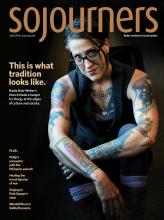MOST MEDIA ACCOUNTS of Nadia Bolz-Weber focus on her tattoos. She has the liturgical year tattooed on one arm, from creation to Pentecost; another features Lazarus still wrapped, but very much alive. She got that one while struggling to write a sermon on Jesus’ raised friend.
The tattoos on a 6’1” woman with a taste for punk, a bad-girl past, and a gay-inclusive church—House for All Sinners and Saints in Denver—make for easy picking for secular media. You may have caught Bolz-Weber’s book Pastrix on the New York Times bestseller list. Wise, self-aware, hipster Christian celebrities have a market for books, and she’s tapped it.
In contrast to much of the superficial media coverage, what’s most interesting about Bolz-Weber is her deep traditionalism. “Secular media doesn’t understand the difference between orthodox and conservative,” she tells me through a toothy smile, blue-green eyes blazing over thick-rimmed ’50s-era glasses.
“House,” as the community calls itself, is almost medieval in its liturgy. There are no instruments, just a cappella chant and pillows for kneelers at a prayer station. The Eucharist is served weekly. Eastern Orthodox iconography drapes the church’s interior, stoles, website, and literature. Latin hymns fill the communion liturgy on the Sunday evening I attend. Bolz-Weber is proud to be using Franz Schubert’s setting for the Mass.
This is not high church fussiness; it is liturgical and churchly orthodoxy for scruffy hipsters. Bolz-Weber explains that many of her fellow social progressives want to jettison the Bible and Jesus in order to be more inclusive. “But why should we jettison the only things we have going for us?” she asks.
Read the Full Article
